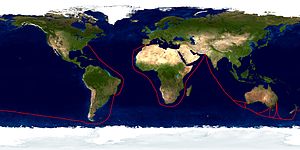| Operation Sea Orbit | |
|---|---|
| Part of Cold War (1962–1979) | |
 Operation Sea Orbit route. | |
| Type | Naval surface warfare and naval air operations |
| Location | World-wide |
| Planned by | United States Navy |
| Objective | First circumnavigation of the world by nuclear-powered surface warships |
| Date | 31 July 1964 to 3 October 1964 |
| Executed by | Rear Admiral Bernard M. Strean, USN Task Force One: • USS Enterprise (CVAN-65) • USS Long Beach (CGN-9) • USS Bainbridge (DLGN-25) • Carrier Air Wing Six (CVW-6) |
| Outcome | Mission successfully accomplished. |

Enterprise, Long Beach, and Bainbridge
Operation Sea Orbit was the 1964 around-the-world cruise of the United States Navy's Task Force One, consisting of USS Enterprise (CVAN-65), USS Long Beach (CGN-9), and USS Bainbridge (DLGN-25). This all-nuclear-powered unit steamed 30,565 miles unrefuelled around the world for sixty-five days.[1][2]
The cruise began on July 31 and ended on October 3.[1] The full itinerary comprised Rabat, Morocco; Dakar, Senegal; Freetown, Sierra Leone; Monrovia, Liberia; Abidjan, Ivory Coast; Nairobi, Kenya; Karachi, West Pakistan; Fremantle, Melbourne, and Sydney in Australia; Wellington, New Zealand; Buenos Aires, Argentina; Montevideo, Uruguay; and Santos, Rio De Janeiro and Recife in Brazil. Enterprise made only three port calls: Karachi, Sydney and Rio De Janeiro.
Operation Sea Orbit was the idea of Vice Admiral John S. McCain, Jr., who saw the exercise – which demonstrated how nuclear-powered ships could operate unfettered by shore logistical ties[2] – as a statement of American technical achievement similar to that of the coal-burning Great White Fleet in 1907-1909.[1] Enterprise was under the command of Captain Frederick H. Michaelis; the guided missile cruiser Long Beach under the command of Captain Frank H. Price, Jr.; and guided missile frigate Bainbridge under the command of Captain Hal C. Castle.[3][4][5]
The mission was commanded by Rear Admiral Bernard M. Strean.[1] The operation gained considerable attention overseas but less in the United States.[1]
Veterans of Operation Sea Orbit gathered on July 30, 2004, for a 40th anniversary reunion.[2] In 2011, Operation Sea Orbit was included in the Technology for the Nuclear Age: Nuclear Propulsion display for the Cold War exhibit at the U.S. Navy Museum in Washington, DC.[6]
See also[]
Notes[]
- ↑ 1.0 1.1 1.2 1.3 1.4 Baldwin, Hanson W. (1964-10-03). "Nuclear Task Force to End World Cruise Today". The New York Times. http://select.nytimes.com/mem/archive/pdf?res=F50D1EF93A5F147A93C1A9178BD95F408685F9.
- ↑ 2.0 2.1 2.2 Thompson, Jason (2004-08-04). "Operation Sea Orbit Veterans Celebrate 40th Anniversary Aboard Big E". United States Navy. http://www.news.navy.mil/search/display.asp?story_id=14569.
- ↑ "USS Enterprise (CVN-65): 1961-1965". Dictionary of American Naval Fighting Ships. Navy Department, Naval History & Heritage Command. http://www.history.navy.mil/danfs/e4/enterprise-viiia.htm. Retrieved 2010-02-24.
- ↑ "USS Long Beach CGN-9". Dictionary of American Naval Fighting Ships. Navy Department, Naval History & Heritage Command. http://www.history.navy.mil/danfs/l8/long_beach-iii.htm. Retrieved 2010-02-24.
- ↑ "USS Bainbridge CGN-25". Dictionary of American Naval Fighting Ships. Navy Department, Naval History & Heritage Command. http://www.history.navy.mil/danfs/b1/bainbridge-iv.htm. Retrieved 2010-02-24.
- ↑ "Technology for the Nuclear Age: Nuclear Propulsion". Cold War Gallery. U.S. Navy Museum. 2011. http://usnavymuseum.org/Ex1_NuclearPropulsion.asp. Retrieved 2011-10-12.
References[]
| Wikimedia Commons has media related to Operation Sea Orbit. |
- JO1 Jon Franklin, USN (January 1965). "Historic 'Show the Flag' Cruise". All Hands. BUPERS - U.S. Navy. http://www.navy.mil/media/allhands/acrobat/ah196501.pdf. Retrieved 2009-07-27.
This article incorporates text from the public domain Dictionary of American Naval Fighting Ships.
- http://www.nukestrat.com/pubs/nep7.pdf - 1994 paper hi-lighting limited, public-relations only value of all-nuclear task groups given continued dependence on conventionally fuelled escorts and continuous replenishment of supplies
The original article can be found at Operation Sea Orbit and the edit history here.